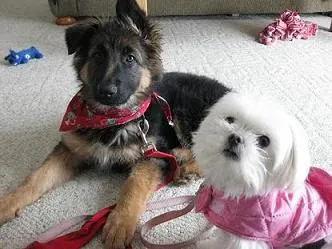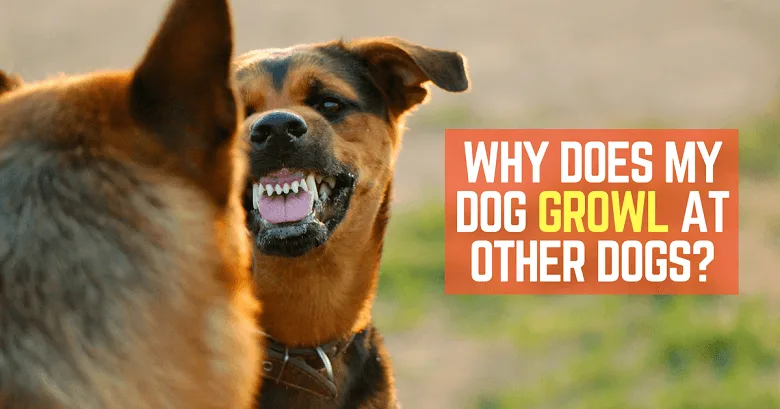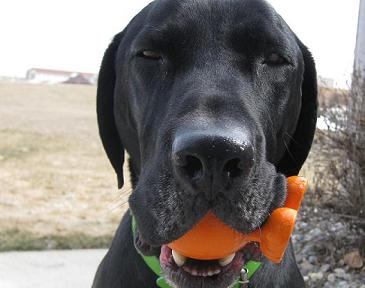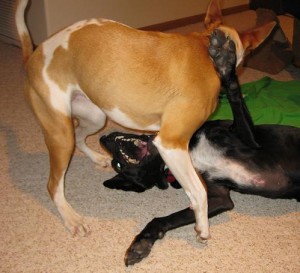Normal, social dogs growl, bark and snap. It’s their way of communicating. Growling is usually not bad.
My mutt Ace is the most gentle dog I know, but he will growl at other dogs when appropriate, like when our puppy won’t stop biting his jowls or when a dog won’t stop humping him at the dog park.
There is usually at least one pest at the dog park who runs around trying to hump everything in sight!
Usually my dog Ace tolerates this behavior for about five seconds. Then he flings his body around. If the “humper” persists, Ace’s hackles go up and he might bark at the other dog – “Do not like!”
If the dog still tries to hump him, that’s when Ace lets out a ferocious growl. This is usually followed by a friendly tail wag – “Hey, I’m a nice guy, but please don’t hump me.” Both dogs shake themselves off and either part ways or play. (2018 update: Ace has passed away.)
I remember when I was pet sitting a German shepherd puppy and an adult Maltese from the same family. The German shepherd was around 45 pounds soon to be 75+ pounds, complete with puppy teeth and clumsy paws. The Maltese was 4 pounds.
If the Maltese didn’t growl at the shepherd, she would get stepped on and injured. She has to draw some limits so the shepherd would back off. I never corrected the Maltese for growling. Instead, I re-directed the shepherd’s attention.

If your dog growls at other dogs, don’t punish him
Growling is a dog’s way of warning us that she is feeling stressed. Dogs that are punished for growling learn to stop giving this warning sign and go right to a snap or bite. Instead of correcting a dog for growling, re-direct her attention and give her a break from whatever is causing her stress.
There are all kinds of scenarios that will cause a normal, social dog to growl. I’ve covered some of them below. Feel free to share more examples and suggestions.
1. It’s normal for dogs to growl when they are playing
When two dogs are wrestling and playing, they will both play growl. It’s easy to tell when both dogs are having fun, because they will show an equal amount of energy.
The more energetic dog will probably roll over on her back and let the other dog “win” so the other dog will feel comfortable “attacking” her. Then they’ll switch. Both dogs will play bite and play growl – and it gets very loud! They might chase each other, bite each other, bark or play tug with the nearest toy.

2. Normal warning growls – dog parks, dog daycares, dog playdates
Normal dogs use growling to communicate after the other dog (or person) has ignored previous warning signs that they’ve had enough.
For example, if one dog no longer wants to play, she will likely stop instigating the wrestling. She will start avoiding the other dog by looking away or pretending to be interested in something else “Oh, this smells good!” She will likely stand up and shake herself off, which dogs will do when they are ending something, kind of like a big sigh of relief – “Well that was fun, what’s next?”
If the other dog continues to pester her, she might yawn (a calming signal) and keep looking away. Next, she might stiffen, raise her lips, crinkle her muzzle and growl.
If the other dog still won’t leave her alone, that’s when she might snap, lunge or let out a vicious bark – “Get the f— off me!”
3. Owners make the mistake of scolding the dog that snapped.
Really, the other dog (the pest) in this example should have been re-directed long before the incident escalated. Younger, more energetic dogs need to learn boundaries, especially if they haven’t been around enough dogs and can’t control their never-ending desires to play. These are the dogs that shouldn’t be at the dog park quite yet. They should socialize in smaller, more controlled groups of dogs first.
In scenarios such as dog daycare or the dog park where one dog won’t leave my dog alone, I re-direct their attentions with toys or food or by calling them.
Sometimes I have Ace sit and stay at my side for a minute to give him a chance to re-group. Usually the other dog runs off and annoys someone else. This “time out” is not a punishment. It’s a chance for my dog to relax and take a break. After a minute or so, my dog is eager to go back and play. If not, then it’s a good time for us to leave the park.
I also call my dog and have him sit at my side whenever a new dog enters the park so my dog isn’t the one overwhelming the newcomer.
4. Dog growls at other dogs when guarding/showing possessiveness of toys or food
Dogs have a tendency to guard food or toys. Ace will growl at other dogs that try to take his resources. This is common dog behavior, although probably not something any of us would like our dogs to do. The dog is saying, “This is mine! Leave me alone!” Typically, the dogs work this out on their own with no issues.

The problem is, some dogs become overly possessive and will bite a dog or person who comes near their food or toy. This is why I do not tolerate any possessive growling from my dog even if he is guarding something that is technically “his.” If he growls at an obnoxious young puppy who needs to learn some rules, I think that is acceptable. But if he growls at my cat walking by who doesn’t even want his toy, that is not acceptable.
I also expect all dogs in my house must understand that everything belongs to the humans first. If Ace wants a toy, he is going to sit first. If he wants to eat, he is going to lie down and wait calmly for a few minutes. I make this process fun and rewarding for the dogs (“Wow, what a good sit! You’re such a good boy!”), not stressful and frustrating.
You also want to teach your dog a command such as “leave it” or “drop” or “trade” and help him associate receiving something even better for obeying. For example, if he drops the rawhide, he gets a piece of chicken. My dog understands “drop” to mean “put it down” and “leave it” to mean “don’t touch that.” He doesn’t need treats to obey these commands, but I try to surprise him every now and then with something wonderful (a tennis ball) for obeying.
For more information on possessiveness, see my post on how to help a dog with toy aggression.
5. Dogs growl when they are scared
Animals will get defensive if they feel threatened, especially if they are cornered.

The key here is that normal, socialized dogs are not going to feel threatened by something ordinary like a dude shoveling his driveway, a kid racing by on a scooter or a big, black dog barking. That’s why it’s important to socialize puppies and dogs to as many different people, sounds and situations as possible throughout their lives.
I want my dog to growl if a strange man is stalking us during an evening walk, for example (although I don’t know if he would). But I don’t want my dog to growl at every man who walks by us after dark. Thankfully, he doesn’t.
Dogs growl!
Dog owners need to remember that growling is a normal part of dog communication.
It is our job to socialize our dogs and give them plenty of opportunities to interact with other dogs. It is also our responsibility to limit the amount of stress our dogs experience and to provide them with safe and constructive ways to deal with the stress they inevitably will experience.
Do you have any questions or examples about your dog’s growling? Leave them in the comments!
Thank you for supporting That Mutt on Patreon! Click here.

Christine
Monday 29th of May 2023
My family has many dogs my dog, Milo gets along with half of them but there are two that he instantly growls and angry barks at. One is a pit bull who can easily kill him. It’s a problem when we are together. Any advice o how to chill my dog out and get him to stop growling? He especially hates when the other dog comes near me .. resource guarding but it’s very stressful. Any advice?
Sally Salter
Thursday 31st of January 2019
I have a 1 year old Brussels Griffon- Huckleberry. When we go to the dog park (small town- not to many dogs there at one time) if we are on the small dog side he will constantly run the fence and bark at the dogs in the larger dog side. He will NOT quit- I have tried distracting- leaching him up and walking him around- and he goes right back at it when unleashed. If I know the large dog on the other side won't hurt him I will take him over there and he does some better. Once he gets to know the large dog he does pretty good, but will have times where he nips and goes after the large dog. I have established a Huckleberry help group of larger dogs (nice ones)that we let them run together when they are there. Can you give me any helpful training advise to get Huckleberry over this little dog that thinks he's big problem?
Lindsay Stordahl
Thursday 31st of January 2019
I don't think it has as much to do with size but I think it's the fence/barrier itself that is making him excited or frustrated. Then when he does get to go over there, he has so much pent-up energy that he sometimes nips. Just guessing, I don't know.
I'm trying to brainstorm some ideas for you and I'm having trouble thinking of anything helpful. If he were my dog, I would probably take him running before heading to the park to try to burn off some of the energy. Then maybe visit in quieter times and use an e-collar with a remote to correct the barking. A long leash, like you suggested, is another option but might take many repetitions over several weeks and it's so challenging to have a long leash on at a fenced dog park.
You might try having him on a long leash on the outside of the entire park (so he's not in the fenced area at all) and walk along the border with him, correcting him for charging and barking and rewarding calm behavior. It just take a lot of time to change the habit.
Serina J Rieckman
Tuesday 29th of January 2019
I walk a dog that purr/ growls when happy to see you. At first intimidating but when she pushes your hand for more pets, you realize she's happy!
Lindsay Stordahl
Tuesday 29th of January 2019
Oh man, that must be confusing! Haha.
Nikki
Monday 9th of July 2018
Hi! I need some help and I'm not sure who to turn to! I have a mixed pitbull who is a little over a year old. He is usually very sweet and loves to play with other dogs. However, very recently he is starting to growl somewhat aggressively at other dogs when I take him on walks and now I am hesitant to take him to the dog park. This has happened 3 times in a row, I'll be walking him and another person will pass with a dog, we will try to let them sniff each other (my dog will seem happy, eager and excited) and then when they get close he suddenly starts to agressively growl and bark. The first time it happened we were at an off leash dog beach and I was playing fetch with him. Another dog was playing with her owner and my dog randomly ran over to the other dog and started to really bark and growl at her (she was maybe 30 ft away initially). I'm so confused as to why he suddenly wants to do this. I know I'm not supposed to scold him for growling because he is communicating, but the other dogs have not even gotten a chance to do anything to him yet. At home he is still obedient and doesn't growl randomly. He may want to bark at someone coming towards the house who he doesn't know but that's it. We do take him out of the house and I feel like he was socialized somewhat well when he was younger (he played at the dog park and beach fairly a lot, and I would take him on walks downtown). I'm at a loss and I just don't want to contribute to the the bad rep pitbull already get...Any advice is truly appreciated!
Lindsay Stordahl
Tuesday 10th of July 2018
Hi Nikki, so sorry to hear that. It's hard to say why he's doing this behavior. I almost wonder if it's related to his age/maturity. I know it's not the simple answer you are looking for, but I think it might be best to meet with a dog trainer you trust in your area and have them observe him and you in a non-biased way. Sometimes just having someone else (experienced) observe the situation can help you realize small things you might not be noticing. Since he is normally very playful with other dogs, I would suggest you make sure you are not adding to the tension by anticipating a reaction from him or adding tension to the leash. Try to stay relaxed like you normally would and anticipate his usual, happy reactions. The book Feisty Fido by Patricia McConnell is also pretty helpful.
And here's a blog post of mine that might help: https://www.thatmutt.com/2015/07/08/stop-a-dog-from-barking-and-growling-at-other-dogs-on-walks/
Ulani
Friday 23rd of March 2018
Wow thanks goodness for this article! I’ve learned something new! I was at the dog park the other day with my 19 week old Belgian. He plays great with all the dogs but yesterday, I saw some stuff I’ve never seen before. He played for a bit and then he started guarding the tennis ball under the table he growled at the other dogs and ran away from dogs and people who tried to get the ball( he was super jumpy). I then asked him to come to me and to drop it, so he could share with the other dogs. But he did come, but didn’t drop it and tried avoiding me. I got alittle frustrated and caught him around the collar. And he flipped out! He growled and whinnied I asked him again to drop it and he didn’t. (He knows this command) so I had to pry it out of his mouth and as I held him I threw the ball for the other dogs. I just wanted him to share the ball with the other dogs but he wasn’t havin it! We took a one minute break and he was eager to play, right back to his old self. He also barks at kids and growls because he gets so excited! I loose control over him when that happens. (I’m still holding the leash it’s just he won’t listen). Any tips will be very much appreciated!